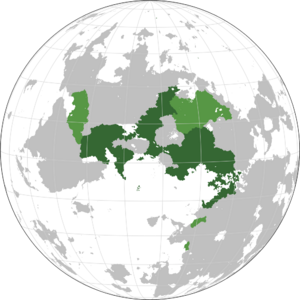Membership in the Sekidean Union
| Member of the Sekidean Union | |
|---|---|
 | |
| Category | Members
|
| Location | Sekidean Union |
| Created | 1983/2012 |
| Number | 10 countries (Inner Sekidean Union) 7 countries (Outer Sekidean Union) |
As defined in the Sekidean Treaty System, the Sekidean Union distinguishes between three terms, the Member state and Member entity, with the Inner Sekidean Union using only a binary distinction between an ISU member and non-members.
History
During the time of the establishment of the Sekidean Union under the articles of the Agreement of the merger of Shanghou Pact and Purple Community into Sekidean Union, no distinction between member entities and member states was made. The treaty, referring to the members, used terms such as "member country", "member nation" or simply "member". This system, although being rather simple, has been found problematic, when Kistolia and Pecia have applied for membership in the Sekidean Union as seperate entities, although they were unified under the Kistolian Union, which, however, guaranteed autonomies the the member states and as such allowed for such a process.
The Sekidean Treaty Court eventually ruled, that in the view of the Treaty, the two are acting as de facto independent entities within the Sekidean Treaty System and should be treated as such. Thus, the name member entity was used. This decision was upheld, when Renia, Monte Blanco and Zhousheng, all member states, merged into the Federation of Mustelaria in 2017, which didn't apply for SU membership, as it was assumed, that all parts of it were already members. The Sekidean Treaty Court ratified the decision and agreed, that despite the existance of Mustelaria, for the purposes of voting within the Cabinet of Leaders, the three former countries remain as official member entities.
However, because of the signing of the Agreement of the Sekidean Union in regards to the defence of the member entities, which specified the need of member state armed forces to take part, the Sekidean Treaty Court made a ruling, that there is a difference between a member state and a member entity. Both the Kistolian Union and Mustelaria are member states and as such must use their militaries in the manner prescribed in the defence of other member states.
In contrast to it, the Sekidean High Court ruled, that within the Inner Sekidean Treaty System, a part of the Sekidean Treaty System, the Kistolian Union and Mustelaria are both considered to be unitary members, and as such should be represented in the Sekidean Parliament.
The Sekidean system has been amended once more to allow for membership of Gassasinia, which has been accepted under a specially amended treaty editing its relation to the Sekidean Charter and the Treaty System as a whole. In this way, the third membership type has been created, named the member associates.
Current members
| SU | ISU | Membership type | |
|---|---|---|---|
| Member entity | Member state | ||
| No | Full member | ||
| No | Full member | ||
| Yes | Full member | ||
| No | Full member | ||
| No | Associate | ||
| Yes | Full member | ||
| Yes | Full member | ||
| No | Full member | ||
| Yes | Full member | ||
| Full member | |||
| Yes | Full member | ||
| Full member | |||
| Full member | |||
| Yes | Full member | ||
| No | Full member | ||
| Yes | Full member | ||
| Yes | Full member | ||
| Yes | Full member | ||
| Yes | Full member | ||
Membership types
Member states
As of October 2024, there are 17 member states in the Sekidean Union. Member states are defined especially in relation to security, military and economic policies. Member states are officially allowed to apply for the membership of the Inner Sekidean Union.
Member entities

As of October 2024, there are 20 member entities in the Sekidean Union. Member entities are the official "members" of the Sekidean Union as defined in the Sekidean Treaty System. Heads of governments of the member constitute the Sekidean Cabinet of Leaders, the highest decisionmaking and legislative body of the Sekidean Union.
Member entities are also responsible for following and enforcing the rules outlined in the Treaty System, and via the Cabinet are also resposible for updating, amending and editing them. The Cabinet is also responsible for overseeing and controlling the accession of new member entities, supsending or freezing the membership of current entities if they transgress or working on economical deals on behalf of the whole Union with non-union states, organizations or unions.
Exceptions are carved out for associates as defined in their respective accession treaties.
ISU members
As of October 2024, there are 10 members of the Inner Sekidean Union. These countries agreed to accept the terms and treaties of the Inner Sekidean Treaty System as well as any legislation passed on the union level. Member states have of the Inner Union use an unified currency, the Sekinar, joint Union-wide parliament, president, governmental cabinet and multiple other joint programs, notably the space program.
Legislations and amendments to the Sekidean Treaty System within the Inner Sekidean part are passed using a bicameral Sekidean Parliament, consisting of the directly elected Sekidean Assembly, which serves as the lower house, and the indirectly elected Sekidean Council, which serves as the upper house.
Associates
Out of 17 member states, 1 associate can be recognized. Associates, unlike full members, have set opt-outs on certain policies of the Sekidean Union. These amended accession treaties, usually referred to as "Treaties of Association" ensure, that the state/entity has looser relation to the Sekidean Treaty System. In turn, the voting rights of these associate entities are limited within the Sekidean Cabinet of Leaders depending on the subject at hand.